
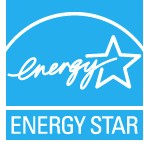
Thank you! We were honored to win this award. The EPA award recognizes businesses that demonstrate their commitment to environmental protection through superior energy management which integrates the use of Energy Star tools and resources. It recognizes our commitment to and success in achieving superior energy management as well as our active participation in the ENERGY STAR program. Saint-Gobain is truly committed, from the top down, to improving energy efficiency which leads to reductions in greenhouse gas emissions. Our CEO truly supports the effort. He sees the value from both a cost savings perspective and an environmental perspective.
Saint-Gobain is proud to be the first and only manufacturer of glass containers or fiberglass insulation to ever receive this award. In 2008 and 2009, Saint-Gobain’s North American energy-use reduction equated to the amount of energy we would require to make nearly over 1.1 billion glass containers or enough fiberglass insulation for over 250,000 typical homes! The savings are equivalent to a reduction in carbon dioxide emissions of about 140,000 metric tons.
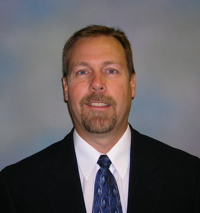
Brad Runda, Manager-Energy, Saint-Gobain Corporation
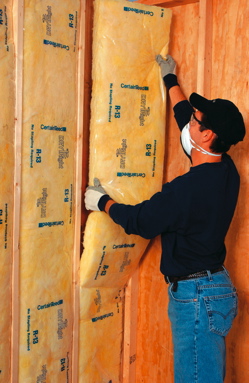
Saint-Gobain Dry Right Fiberglass Insulation
What specific actions at Saint-Gobain were recognized by ENERGY STAR for this award?
The key Saint-Gobain energy management accomplishments recognized by ENERGY STAR for 2010 award were the following:
- Accomplishing a 2.2 % reduction in energy intensity in spite of the economic downturn.
- Expanding the company’s network of energy champions to impact 98% of its energy consumption.
- Improving the company’s energy culture and in-house resources, evidenced by an increased number of facility energy assessments conducted internally by company teams.
- Contributing to EPA’s completion of the ENERGY STAR energy performance indicator for container glass plants by extensively testing the tool.
- Leading the glass container industry by encouraging executives in the industry to take advantage of ENERGY STAR resources to help them improve energy performance in their companies.
- Working within its Energy Value Chain to promote energy management with ENERGY STAR, both upstream and downstream of the company.
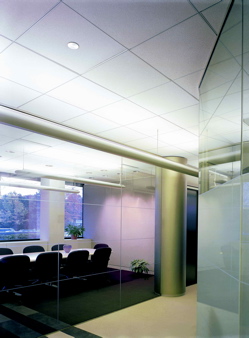
Saint-Gobain Adagio Ceiling Panels
How is Energy Management structured at Saint-Gobain?
Saint-Gobain pursues energy reductions in three primary areas: buildings, transportation, and manufacturing facilities. My role is to focus on manufacturing and buildings. We have over 140 manufacturing facilities in Canada and the U.S. and over 150 sites that are involved in building materials distribution. Another person in the company focuses on transportation.
I work at the Saint-Gobain corporate level. I champion efforts for culture change around energy efficiency. I manage and oversee the over-all energy efficiency efforts of the company. I help coordinate projects, work with third parties, and am responsible for the agreements reached with the energy management supplier base. I work with the dozens of people in the business units who have responsibility for energy management. Internal selling is an important part of what I do.
We have four main divisions: Construction Products (CertainTeed) Containers, Innovative Materials, and Building Materials Distribution (Norandex). Each division contains Energy Champions who are responsible for energy efficiency within their respective business units. The divisions have an executive-level sponsor. I will work with the sponsors and Energy Champions to understand and help accomplish their goals. Yearly plans are made by each division and we track our progress with metrics and monthly and quarterly conference calls.
Some divisions, like Containers, are more energy intensive due to the nature of the process. They correspondingly have a larger staff of Energy Champions than other divisions. Our goal is for every plant to have an Energy Team which coordinates with the respective Energy Champion to identify, prioritize and execute energy efficiency projects. I sometimes help the plants directly on specific projects.
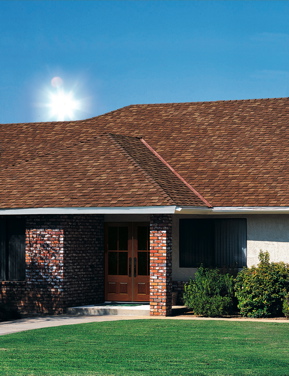
Saint-Gobain Landmark Solaris Roofing Shingles
How does Saint-Gobain communicate the results of energy management?
It is critical to have a communications strategy. Our strategy focuses on letting our own employees know what we are accomplishing with energy efficiency and with ENERGY STAR. We have a strong level of support from our internal communications people - both at the corporate level and in the business units.
We publish success stories and energy related articles in the weekly “North American Business Report”, our company e-newsletter. The articles communicate internal actions and programs where we have saved energy and announce which of our own products have received the ENERGY STAR rating.
Our energy program grows as people help promote it. We try to raise awareness which leads to participation in the efforts, causing people to think about it and practice it. It has the effect of changing the culture of the business you work in. We want an internal culture of energy awareness within the company.
What advice would you offer to Energy Managers starting a program?
Senior management support is essential. It really helps things along when the CEO comes out with a commitment to the energy program. I recommend becoming an ENERGY STAR partner company and being active within the ENERGY STAR program. It is important to network with people and see what they are doing with energy management both inside and outside of your own industry. This is the big advantage of being connected to the ENERGY STAR program. It’s a nice network of folks willing to share ideas. Networking is particularly important if you are just getting started with energy management.
There are a whole host of ideas and resources provided through ENERGY STAR including how to get started. Don’t be afraid to ask questions of people who have “been there and done that”. People involved with are usually willing to share ideas.
How did you get involved with the energy management program at Saint-Gobain?
I have been working at Saint-Gobain for over nine years. My first position within Saint-Gobain was the Energy Manager for the Containers division. Earlier in my career, I worked in the key accounts group of a utility company. Part of my job was to help key account customers reduce their energy consumption. That was when I got “hooked” on reducing energy consumption.
When I first started in the Energy Manager position covering Saint-Gobain North America, I knew one thing - we had to hit the ground running. We wanted to save money and energy during year one of the program. The challenge was that we have over 150 plants in North America – with dozens of unique processes. Developing the network of Energy Champions and Energy Teams was a big key to success. We couldn’t afford to get caught up in over-analysis, so we asked a lot of basic questions and then established reasonable goals for energy savings. We push hard to identify low-cost and no-cost ideas we can implement quickly. Compressed air is an area that always presents opportunity so we targeted compressed air system assessments. We knew there was low-hanging fruit there, capable of delivering results during year one of the program.
What metrics are used to measure results?
Performance metrics are based upon our goal which is to reduce the energy consumption per unit of product produced at Saint-Gobain. We use metrics like “btu’s per ton” and “kWh per ton”. At the plant level, these are readily understood metrics that lead to cost savings and also to good discussions. There are a lot of things that come out of that.
An external metric we use is the ENERGY STAR Energy Performance Indicator for Glass Containers. That is a measure that we use to benchmark our performance against. How many mmbtu’s does it take to make a ton of glass? We know how many it takes for all of our furnaces and we try to benchmark against all our plants across the globe.
What specific energy efficiency projects do you focus on?
There is always a concern about the integrity of the process. People that run plants are paid to produce profitably and we are very conscious about understanding the processes and making sure that energy efficiency projects don’t hurt our capabilities to produce. On the contrary, they should enhance our ability to produce. I always remind our plant managers that I’ve never done an energy efficiency project (like lighting, compressed air, drives, ect…) that hasn’t helped their processes.
Things really do depend upon specific processes at specific plants. We have conducted a lot of Energy Kaizen events. We also focus on low-cost initiatives. The most common projects involve primarily lighting, compressed air, and combustion efficiency (natural gas).
As an example, in our glass related processes, the biggest energy consumer is the melter. It’s a large furnace made out of thick refractory material, covered in insulation. You put raw materials and recycled glass in it to melt the glass at 2800 °F. You have losses in the walls and the exhaust. We focus a lot on this opportunity. The glass businesses are also a significant user of compressed air and we have spent a lot of time these systems.
How important is compressed air as an energy-source at Saint-Gobain?
It depends upon the process, but it’s safe to say that compressed air plays a critical role in most of our processes. Without compressed air, we simply can’t make most of our products. For example, if you want to form a glass container, you need a substantial amount of compressed air. Compressed air is a vital and expensive utility and we definitely want to manage it properly. We use all types of air compressors throughout the company.
How has Saint-Gobain gone about optimizing compressed air systems? What has the process been and please describe some over-all results.
Our process begins, in each facility, with a system assessment. We really like to work with a credible, unbiased company to do the assessments. When you perform compressed air assessments you have to look at the supply and demand sides at the same time. You can’t focus on one side and not the other. Leaks are a great example. You can fix all the leaks in the plant and not save any energy. If your compressor goes into blowoff - what have you saved? Nothing. You have to go back to air compressors and make sure they aren’t in blowoff. Once you’ve done that, you’ve accomplished the savings.
Being able to measure various parts of the system is key. A thorough compressed air system assessment will provide measurements of not only energy consumption (kW, kWh), but will also measure how much cfm is being used (on a per unit basis) in the production processes.
Please describe some specific actions taken with compressed air systems.
We have had good success with central monitoring and control systems in compressor rooms where you have multiple air compressors. Some have thousands of horsepower of connected load. These centralized control systems can help improve the process – not just reduce energy costs. They can help reduce downtime, make repairs planned events vs. emergency events, and also avoid the use of emergency backup rental air compressors.
A good measurement and control system can also provide better quality compressed air. A good controls system helps to avoid pressure swings. We have found that control system help save energy but, more importantly, improve the consistency and quality of the compressed air. Managing dewpoint is another example. This translates into process improvements in our plants.
We have had good experiences with all the optimization opportunity-areas with compressed air systems. We have focused on fixing compressed air leaks and then making sure our compressor controls can capitalize on the reduced artificial demand. A leak management system is important to maintain. We operate all makes and types of air compressors; rotary screws, centrifugals, and recips. They all have unique issues. Piping/storage is also a common opportunity that we typically see. Last but not least is new compressor technology. When you have older/bigger centrifugals, you can find savings by purchasing newer air compressor technology.
I wouldn’t say, however, that there are any huge movements, major step changes, in air compressor technology. Often incentives help decide the technology we implement. Local utility incentives can lead us to move to a VFD rotary screw air compressor to replace an existing screw - due to a payback improved by the utility incentive.
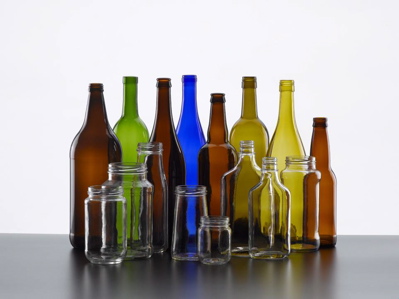
Saint-Gobain Glass Containers
How do you optimize compressed air dryers and filters?
We do the math on compressed air dryers. We like the heat of compression type dryers and have some installed when those dewpoints are required. They aren’t inexpensive though so the numbers don’t always work. We will put them in where we have good utility incentives. In other places refrigerated dryers make the most sense. One thing I look for when buying a refrigerated air dryer, is to only consume energy when I need to. I’m a particular proponent of cycling refrigerated air dryers.
The issue with compressed air filters is to maintain them on a timely basis. We’ve been guilty of cranking up plant pressure due to untimely filter maintenance. The timely execution of filter maintenance programs is very important to protect air quality and system pressure.
Thank you very much for your insights.
For more information, please contact Rod Smith.



